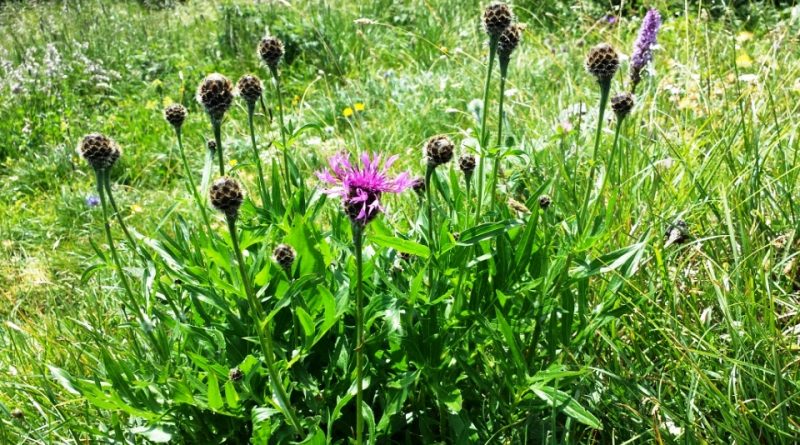Cyanus montanus
Cyanus montanus
The mountain cornflower (Cyanus montanus (L.) Hill, 1768) is a perennial herbaceous species belonging to the Asteraceae family.
Systematics –
From a systematic point of view it belongs to the Eukaryota Domain, Kingdom Plantae, Spermatophyta Superdivision, Magnoliophyta Division, Magnoliopsida Class, Asteridae Subclass, Asterales Order, Asteraceae Family, Cichorioideae Subfamily, Cardueae Tribe, Centaureinae Sub-tribe and therefore to the Specie C. montanus and to the Genus Cyanus. .
This species has been classified over the times with various names of which, below, the most used and frequent are reported:
– Centaurea angustifolia Mill .;
– Centaurea montana L .;
– Centaurea montana L. subsp. angustifolia (Mill.) P. Fourn .;
– Centaurea montana L. subsp. Montana;
– Centaurea montana L. var. alba Hort .;
– Centaurea montana L. var. Montana;
– Cyanus montanus subsp. montanus.
Etymology –
The term Centaurea is assonant with the Greek κέντρον céntron goad, spur: due to the shape of the bud, or from Centaurus, Greek κένταυρος céntauros centaur, mythological figure half man and half horse; according to some authors, this genre would be dedicated to Chiron who, unlike the other centaurs, had a wise and meek disposition: an expert in science and medicine, he was considered the teacher of Aesculapius, Achilles and other heroes.
The specific mountain epithet comes from mons montis monte: of the mountains, mountain, reference to the growth horizon (1000-1400 m).
Geographic Distribution and Habitat –
The mountain cornflower is present in Europe in the Alps, France, Switzerland, Austria and Slovenia, while on the European reliefs it is found in the Black Forest, Vosges, Jura Massif, Massif Central and Pyrenees.
In Italy this species is present in the Alps and in the Apennines (up to the Apromonte) and is considered a rare species.
Its habitat is that of light woods, rich meadows and shrubs, especially in the formations in Adenostyles, in scrublands with Cypripedium, in meadows in Trisetum, with optimum in the mountain belt.
The preferred growth substrate is both calcareous and siliceous with basic pH, medium nutritional values of the soil which must be moderately humid.
Its altitudinal distribution is on the reliefs where it can be found from 300 up to 1900 m s.l.m .; therefore they frequent the following vegetational levels: mountain and subalpine as well as partly the hilly one.
Description –
The mountain cornflower is a perennial plant, often rhizomatous, with a herbaceous appearance. In the area where it lives it has a covering behavior with respect to the ground.
It has erect, robust, winged, simple or little branched stems, scarcely pubescent, 50 to 70 cm high.
The leaves are 9-13 cm long, alternate, oval, lanceolate, linear and acute at the apex, long running directly from the stem, the upper ones are often longer than the flower heads, covered, in particular the young ones, by white hairs that make the slightly tormented and flaky appearance.
The flowers are radiant with bright blue linear laciniae. The inside of the flower is purple in color.
The flowering period is June-August.
The fruit is an achene (cypsela), surmounted by a long pappus, 4.2-7.4 x 2.4-3 mm, oblong ovoid, compressed, yellowish-brown, a little hairy, elliptic hilum, lateral adaxial. Double pappus, persistent, with external hairs in various rows, of 0.4-1.8 mm, rough, yellowish, erect patent, the insides smaller, silky, whitish.
Cultivation –
Cyanus montanus is a rare spontaneous species that is pollinated by insects (entomogamous pollination).
Fertilization basically takes place via pollination of the flowers.
The seeds falling to the ground (after having been carried for a few meters by the wind thanks to the pappus – anemocora dissemination) are subsequently dispersed mainly by insects such as ants (myrmecoria dissemination).
Customs and Traditions –
The mountain cornflower has no particular medical uses apart from its generic febrifugal ability, or at least there are no in-depth studies on the matter. The main use that can be made of it is to use this plant in infusions, to flavor hot wine, for the preparation of digestives and aperitifs. Thanks to its bitter properties, it fully stimulates the appetite.
However, according to popular medicine, the mountain centaurea has the following healing properties:
– antitussive;
– astringents (limits the secretion of liquids);
– diuretic (facilitates the release of urine);
– emmenagoga (regulates menstrual flow);
– ophthalmic (facilitates the flow of blood to the eyes and therefore strengthens resistance to infections);
– purgative;
– tonic (strengthens the organism in general).
This plant can be confused with other species; between these:
– the Cyanus triumfetti species is very similar. The two species are distinguished by the following characteristics: C. triumfetti: the cilia on each side of the appendage of the scales are pale and are from 9 to 15; they are also longer than the underlying brown or black margin; the felted parts are devoid of multicellular hair; the leaves are slightly narrower and the upper ones do not exceed the flower head: C. montanus: the cilia on each side of the appendage of the scales are black and are from 5 to 9 and are no longer than the underlying black margin; the felted parts are mixed with multicellular hairs; the leaves are slightly wider and the upper ones surpass the flower head.
Preparation Method –
The flower heads of this plant are used in infusions, to flavor hot wine, for the preparation of digestives and aperitifs.
Guido Bissanti
Sources
– Acta Plantarum – Flora of the Italian Regions.
– Wikipedia, the free encyclopedia.
– Treben M., 2000. Health from the Lord’s Pharmacy, Advice and experiences with medicinal herbs, Ennsthaler Editore
– Pignatti S., 1982. Flora of Italy, Edagricole, Bologna.
– Conti F., Abbate G., Alessandrini A., Blasi C. (edited by), 2005. An annotated checklist of the Italian vascular flora, Palombi Editore.
Warning: Pharmaceutical applications and alimurgical uses are indicated for informational purposes only, they do not represent in any way a medical prescription; we therefore decline all responsibility for their use for curative, aesthetic or food purposes.


